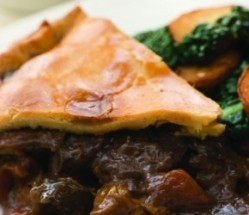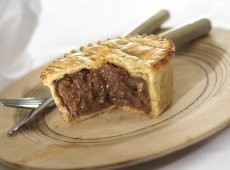British Pie Week 2014: Top tips for tasty pies

Yes, Pieminister
Pies do have a bad name for being an unhealthy choice, but they don’t have to be. One option is to look at the fat content of the pastry used, which is what pie supplier Pieminister has just done. The company, which operates a number of retail outlets and distributes pies to pubs, is launching three varieties next month.
The new arrivals boast greater health credentials, with fewer than 440 calories per (240g) pie, and are designed to be enjoyed cold and hot. One new pie contains butternut squash, sun-dried tomatoes and feta, topped with a pumpkin seed and feta crumb. They will be available at Pieminister pubs running the Pie Pub Package, such as the Gladstone in Borough, south-east London, which sells around 200 pies a week. They are served on their own or with mushy peas, gravy and mash.
Twist of classics
Steak pie variants always go down well and EBLEX recommends experimenting with some of the more weird but wonderful pairings, such as steak and oyster. Foodservice project manager Hugh Judd advises: “A delicious steak or beef pie filling is best prepared with more economical slow-cooked cuts, and the inclusion of offal, such as kidney, will help generate additional value.”
While steak may be the favourite for hot pastry dishes, pork is incredibly popular and there are many people who love a pork pie or a sausage roll, or both. BPEX suggests including pork pies on the menu, but with a point of difference, such as pork and apple, or a pork and mushroom, filling. In addition, sausage and tomato; ham and cheese; or bacon and eggs pies could be popular options, making use of stock ingredients and adding value to the menu.
Game fillings
With the game available to him on the Pipe & Glass Inn estate in South Dalton, East Yorkshire, chef-owner James Mackenzie has a range of game pies that he rotates on the menu. The venison and juniper suet pudding “sells really well” and the pastry is flavoured with juniper and herbs for a greater depth of taste. The Pipe & Glass team also knocks up mini hare pasties as starters at £8.95. “When we do a pasty we put flavour in there,” says Mackenzie. “It needs to have intensity of flavour and moistness as well.”
A staple on the menu is the fish pie, which sells at least 60 a week out of an average 850 weekly covers. It is made with smoked haddock, salmon, pollock and Scarborough woof, and served with parsley mash, brown shrimp and fennel salad for £15.95. “Our fish pie is made to order — we just need to heat the sauce up and cook the fish, so it takes a maximum of 15 minutes to put together.”
Buying-in options
Making pies in-house can take a lot of time and space. Peter’s Food Service offers a gastropub pie range including beef Wellington with mushrooms, pâté and redcurrant jelly; steak and red wine with root vegetables; steak and Oloroso sherry; and chicken and mushroom with white wine and pecorino cheese.
Foodservice director James Osgood says the pies give pubs an opportunity to make a high GP and recommends that chefs use them to make a mini-pie menu, put on pie-themed nights or offer a ‘Pie of the Week’ promotion.
Beef up your offer
No promos are needed at the Parlour in Kensal Green, north-west London, as the sheer volume of pies sold at Jesse Dunford Wood’s pub speaks for itself. Of an average 600 covers a week, roughly 100 Cow Pies are ordered — the only pie on the menu. What really stands out about the Parlour’s pie is that it comes with a bone in the middle, which Dunford Wood uses as a way of adding flavour to the dish.
“We buy in fresh bones filled with bone marrow for 60p each,” he explains. “We take the marrow out, chop it up and add butter, parsley, breadcrumbs, Dijon mustard and chopped, cooked onion to make a stuffing, which is placed back into the bones.
“After 12 minutes of cooking we add the bone with the stuffing and cook for four minutes more. Most people love it and love the fact that the pie has a bone in it. It provides a nice, mustardy, fatty accompaniment to the rich, delicious beef pie.”A week’s worth of filling is cooked for 12 hours and added cold to home-made suet pastry. The pastry is made with layers of rendered beef fat instead of the layers of butter and flour that characterise puff.
“We could use puff pastry and it would look and taste similar, but it is all about being right for the dish.” The Parlour’s Kitchen Table sees up to eight diners treated to a plethora of food and, when they are asked at the end to name their favourite dish, Dunford Wood estimates that around 80% sing the praises of the Cow Pie.
For more details, tips and recipes visit the British Pie Week website.







